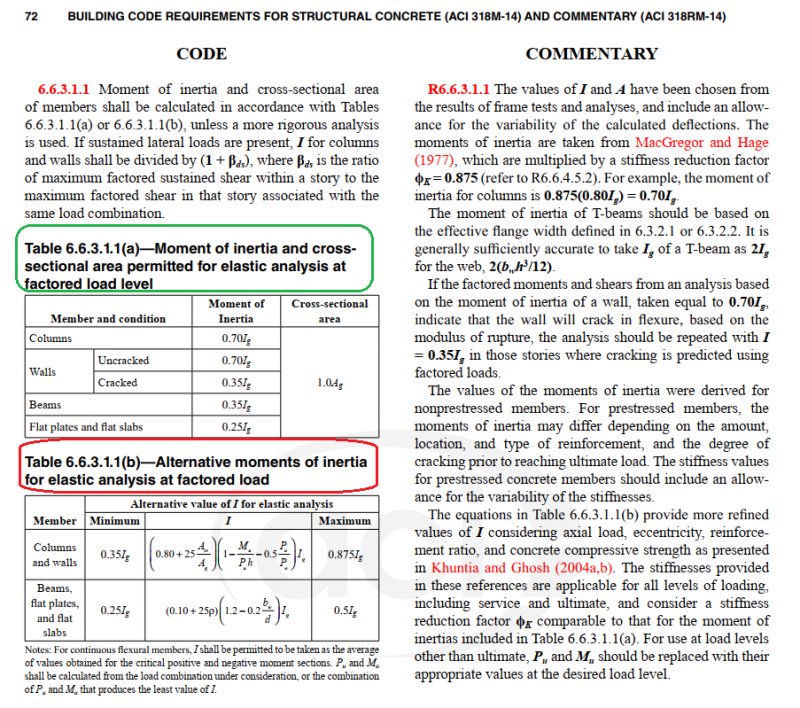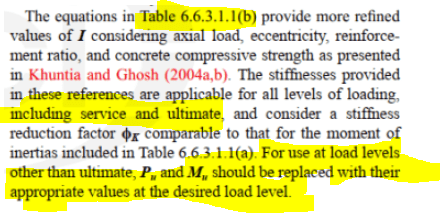Navigation
Install the app
How to install the app on iOS
Follow along with the video below to see how to install our site as a web app on your home screen.
Note: This feature may not be available in some browsers.
More options
Style variation
-
Congratulations cowski on being selected by the Eng-Tips community for having the most helpful posts in the forums last week. Way to Go!
You are using an out of date browser. It may not display this or other websites correctly.
You should upgrade or use an alternative browser.
You should upgrade or use an alternative browser.
Moment of Inertia and Cross-Sectional Area
- Thread starter SPR Baker
- Start date
- Status
- Not open for further replies.
Factored load level refers to an ultimate limit state (ULS) (i.e. safety critical, if it exceeds this it may fail). Unfactored loads, also sometimes called service loads, refer to a serviceability limit state (SLS), which is not safety critical (i.e. how do people feel using this building day-to-day; does it deflect too much? vibrate too much?).
The factors shown in your image refer to the stiffness modifiers when analyzing at the ULS. At the ULS, concrete will typically be cracking or entering the plastic deformation region, resulting in lower stiffness and larger deflections, possibly driving a P-Delta effect and increasing loading. Because we typically complete elastic analyses (which are linear), we need to account for that lower stiffness that results from the plastic region & cracking (which are non-linear effects). These stiffness factors account for that lower stiffness, allowing P-Delta and other increases to be accounted for at ULS using elastic analysis.
The factors shown in your image refer to the stiffness modifiers when analyzing at the ULS. At the ULS, concrete will typically be cracking or entering the plastic deformation region, resulting in lower stiffness and larger deflections, possibly driving a P-Delta effect and increasing loading. Because we typically complete elastic analyses (which are linear), we need to account for that lower stiffness that results from the plastic region & cracking (which are non-linear effects). These stiffness factors account for that lower stiffness, allowing P-Delta and other increases to be accounted for at ULS using elastic analysis.
- Thread starter
- #3
Thank u for nice explaination but
I am stil uncertent to use these tables and when use table 1 and when use table 2? And i don’t understand the word “Factored Load Level” and Factored Load? What really mean?
Table 6.6.3.1.1(a)-[---] at Factored Load Level
Table 6.6.3.1.1(b)-[---] at Factored Load
I am stil uncertent to use these tables and when use table 1 and when use table 2? And i don’t understand the word “Factored Load Level” and Factored Load? What really mean?
Table 6.6.3.1.1(a)-[---] at Factored Load Level
Table 6.6.3.1.1(b)-[---] at Factored Load
You may use either table, but just be consistent. Table 6.6.3.1.1(a) is for use where you don't want/need to be extremely accurate with your stiffness reduction or don't know your load levels yet, and you apply the factors to everything equally. This essentially assumes all elements are losing stiffness equally, which is likely incorrect but close enough to capture the (already imprecise) non-linear effects. It is quicker and easier, but doesn't account for load levels in specific members. Table 6.6.3.1.1(b) is for where you wish to be precise and where you know your loads. It can be applied at ultimate or at service levels (by changing to applicable P and M). It requires iteration and is more time intensive, but may yield slightly better results. It remains capped between the moment of inertia calculated by Table 6.6.3.1.1(a) and a value with a stiffness reduction factor (phi_K). It's up to you to determine whether the additional time is worth the additional accuracy, although I doubt it will be worth it in typical cases.
If you're hung up on "factored load level" vs "factored load", I'm pretty sure they should both read "factored load level".
If you're hung up on "factored load level" vs "factored load", I'm pretty sure they should both read "factored load level".
- Thread starter
- #5
BridgeSmith
Structural
The factored load level refers to a degree of loading that includes an increase factor to account for the possible variation in the actual loading conditions.
Dowels93 said:Factored load level refers to an ultimate limit state (ULS)
Phearun Seng said:What Level load refers?
Just to be clear, you need to apply the moment of inertia reduction for any ultimate limit state analysis where the moment exceeds the cracking moment. For most well proportioned structures this is always going to be the case. It has nothing to do with floors/levels experiencing tensions that might exceed the tension stress limit..
Settingsun
Structural
Replace "at factored load" with "under ultimate limit state loading".
Replace "at factored load level" with "under ultimate limit state loading". As others have said, the word 'level' doesn't change the meaning at all.
It has nothing to do with ground floor, first floor, or second floor of a building. It only relates to the loading (ultimate limit state).
It's your choice whether to use table A or table B.
Replace "at factored load level" with "under ultimate limit state loading". As others have said, the word 'level' doesn't change the meaning at all.
It has nothing to do with ground floor, first floor, or second floor of a building. It only relates to the loading (ultimate limit state).
It's your choice whether to use table A or table B.
- Thread starter
- #11
- Status
- Not open for further replies.
Similar threads
- Solved
- Replies
- 4
- Views
- 4K
- Locked
- Question
- Replies
- 17
- Views
- 5K
- Question
- Replies
- 1
- Views
- 10K
- Question
- Replies
- 6
- Views
- 8K
- Replies
- 9
- Views
- 8K


